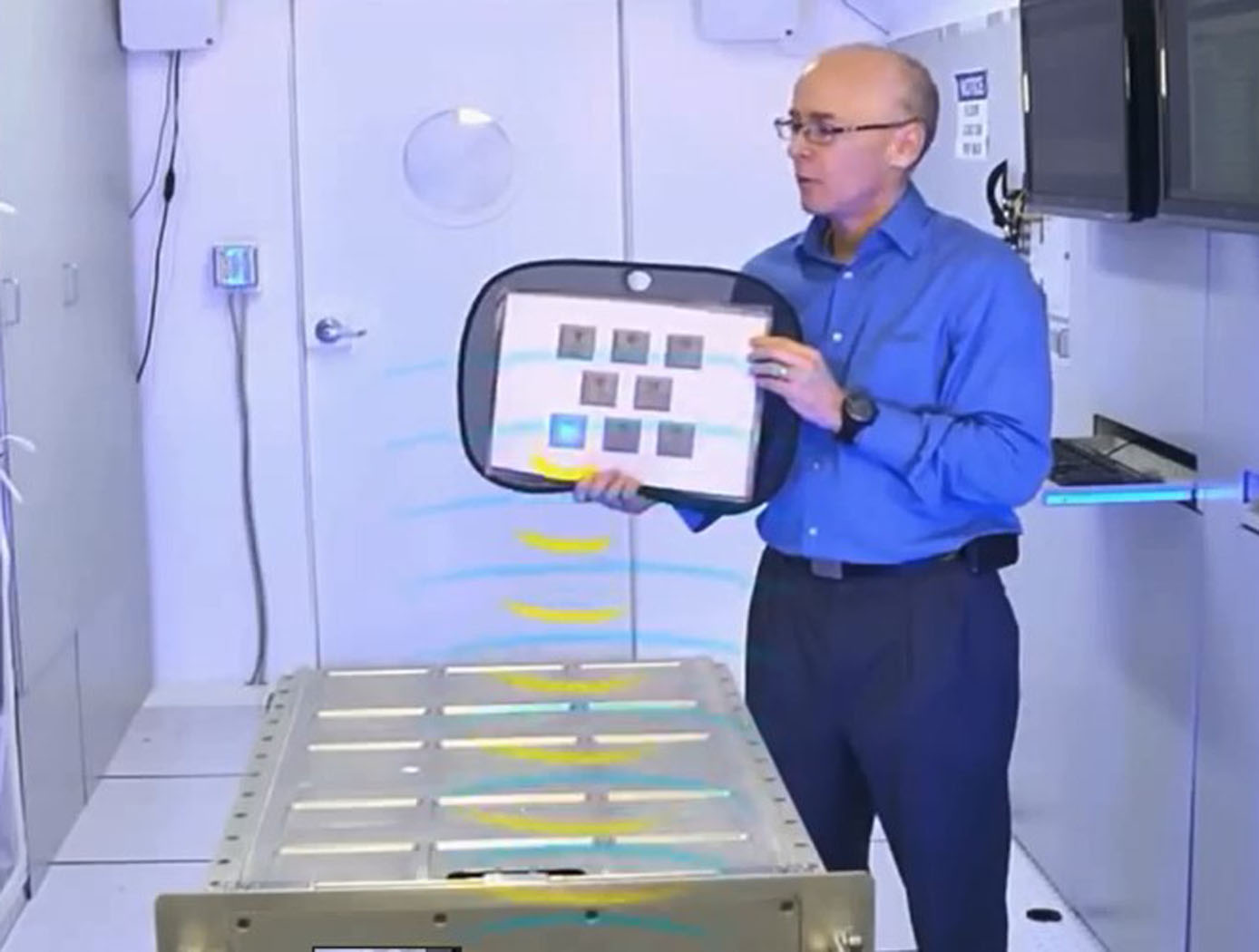RFID Tag for Long Range and Wide Coverage Capabilities
Sensors
RFID Tag for Long Range and Wide Coverage Capabilities (MSC-TOPS-51)
Radio Frequency Identification (RFID) Beamformed Retroreflector Technology
Overview
Researchers at the NASA Johnson Space Center have created a suite of RFID technologies focused in the areas of inventory management and tracking systems and one of those technologies is the RFID Tag with Long Range and Wide Coverage Capabilities. This technology can be integrated to a RFID Tag with a beamforming network capable of receiving and sending long range signals from different directions. Typical RFID tags offer either wide coverage with limited range or long range with narrow coverage. However, this technology, which can even employ passive RFID tags, is capable of doing both, opening the RFID technology to a new spectrum of applications, including inventory tracking, navigational systems, and predictive analytics. With its dual benefits of long range and broad coverage made available by retroreflection, these RFID tags can easily enhance existing RFID infrastructure to enable new applications in many industries.
The Technology
The RFID Tag with Long Range and Wide Coverage Capabilities technology allows a RFID tag to direct a RFID reader beam signal back in the direction of arrival. This technology requires no added power to provide telemetry for long range readers by using multiple beams instead of one narrow beam signal. Each of the predetermined number of beams is typically associated with a unique identification number to derive bearing information. This innovation is suited for IC-based RFID tags as well as Surface Acoustics Wave (SAW) tags, which are useful for extreme environments.
The technology improves the ability to obtain telemetry (quantity, location, or sensor information) without GPS over a distant range. When the tag reports its identification, it also provides angular information to the source, which makes this technology useful for navigation and mapping applications. Because the technology provides an estimated angle between the signal antenna and the surface of each tag, the technology is able to triangulate the position of a mobile item identified with a RFID tag. The same innovation can be integrated to a RFID reader in order to enhance its range and distribute power to passive tags. The innovation has commercial applications in construction, oil and gas, seaport/harbor management, Internet of Things (IoT) and many more industries.


Benefits
- Flexibility - can use IC-based RFID tags or SAW tags
- Range - allows a reader to detect tag information over greater distances
- Low Power Requirement - passive RFID tags are used without the need for tag power
- Enhancement- provides tools and applications with sensory capabilities
- Location aide - can determine location without GPS
Applications
- Construction - RFID navigation and mapping technology
- Oil and Gas - companies seeking passive sensor capabilities with suitable extended range
- Logistics/Inventory - tracks location, movement, quantity, etc. of items and/or lots
- Seaport/Harbor Management - long distance tracking of shipment boxes
- IoT - enhance capabilities on predictive analytics, security, and inventory management systems
|
Related Links:
|
Similar Results

RFID Tags Collaborate for Data Retrieval
Commonly used RFID protocols are widely accepted because they are inexpensive and easy to implement. However, the associated low transmit power and narrow bandwidth typically result in coarse local-ization estimates. Often it is desirable to know the precise location of assets without reverting to an entirely different and more expensive protocol. Additionally, many industrial and other applications may desire technology that confirms the mating of components. This new program-mable sensor tag technology facilitates both precise localization and mating confirmation in-part by allowing the RFID sensor tag to become a type of distributed low-cost reader.
To determine a tag attachment, this innovation utilizes a fixed location RFID sensor tag that incorporates a receptacle node to measure an electrical “influence” through resistance, capacitance, inductance, etc. Assets for which localization is desired are outfitted with “influence tags” – devices that produce a set of distinguishable responses when placed in the receptacle region of the RFID sensor tag. Mating or connections are confirmed when electrodes from an influence tag become attached to matching electrodes on a sensor tag’s receptacle node. Information obtained by the RFID sensor tag is stored in its local memory bank through which a dedicated reader can retrieve influence tag information.
Potential applications exist for this technology where specific assets need to be precisely located and/or confirmation is needed when two parts have been correctly connected or attached. This RFID tag technology allows the retrieval of inventory status information in an energy efficient manner from inexpensive, small form factor hardware. Robotic retrieval of assets can be more easily facilitated with this innovation.

Passive Smart Container
Passive Smart Container system comprises four major components: RFID circuits embedded in or around the container, an antenna and RF distribution system, and an interrogator/reader. The system uses passive RFID circuits placed on a bulk item container to track consumption and quantify items as the items are removed, added or replaced in the container. The antenna is strategically integrated with the lid or elsewhere in or around the container and is constantly coupling RFID signals to/from the RFID circuits. The circuits reply with information regarding the fill level in the container. A processor connected to the reader/interrogator can infer the fill level according to which RFID circuits respond and the magnitude and phase of the returned signals. The technology is compatible with the EPCglobal Class-1 Generation-2 RFID standard. This setup can be modified to track all kinds of items, large and small, making this technology suitable and applicable to an array of commercial fields.
RFID is a disruptive technology that has made a large impact on several industries, especially in supply chain and asset management. Passive Smart Container is well positioned to tap into this growing market. Its ability to account for discrete items as well as liquids and bulk goods that were deemed impossible or impractical to tag makes this technology relevant for an array of applications and industries.

Smart Enclosure using RFID for Inventory Tracking
The smart enclosure innovation employs traditional RFID cavities, resonators, and filters to provide standing electromagnetic waves within the enclosed volume in order to provide a pervasive field distribution of energy. A high level of read accuracy is achieved by using the contained electromagnetic field levels within the smart enclosure. With this method, more item level tags are successfully identified compared to approaches in which the items are radiated by an incident plane wave. The use of contained electromagnetic fields reduces the cost of the tag antenna; making it cost-effective to tag smaller items.
RFID-enabled conductive enclosures have been previously developed, but did not employ specific cavity-design techniques to optimize performance within the enclosure. Also, specific cavity feed approaches provide much better distribution of fields for higher read accuracy. This technology does not restrict the enclosure surface to rectangular or cylindrical shapes; other enclosure forms can also be used. For example, the technology has been demonstrated in textiles such as duffle bags and backpacks. Potential commercial applications include inventory tracking for containers such as waste receptacles, storage containers, and conveyor belts used in grocery checkout stations.

Agile RFID Antenna System
Current RFID readers, such as the EPC Global Class 1 Gen 2, are limited by narrow bandwidth restrictions, maximum transmit power, and a limited number of RF ports, which results in relatively coarse ranging resolution and accuracy, limited techniques for localization, and limited antenna functionality. Some of the currently available solutions, such as using larger antennas or adding switched multiplexers, often result in unacceptable cost, volume, aesthetics and mass penalties. The Agile RFID Antenna System integrates a frequency multiplexer into the RFID reader antenna system to provide greater antenna functionality without requiring additional reader RF ports, resulting in improvements in reader-tag communications read accuracy, read range, and localization.
The Agile RFID Antenna System is at a TRL 8 (Technology has been proven to work in its final form and under expected conditions) and has been used on the International Space Station to support logistics management and it is now available for your company to license and develop into a commercial product. Please note that NASA does not manufacture products itself for commercial sale.

Wearable RFID Sensor Tags Yield Extended Operational Times
This technology exploits the inherently passive nature of RFID to approximate the services provided by traditional active Internet of Things (IOT) protocols like ZigBee and Bluetooth. A novel store-and-forward overlay on COTS RFID protocols allows an RFID active tags to transit through an ecosystem of RFID interrogators, exploiting contact opportunities as they arise and quietly transfers sensor readings at nearly no power cost to the RFID active tag. Specific intelligence built into both the interrogator and the tag leverages the RFID tag user memory (UM) as a stand-in IOT interface. The tag operates by sampling data into timestamped packets and loads them into tag memory. When an interrogator in the ecosystem realizes that a tag is in view and that there is unrecovered data on the tag, it takes custody of the sensor data packet and offloads the data into a database. A smart scheduler reads from the population of interrogators and schedules data transfers for specific tags when an interrogator can seed the custody transfer process for the data packets. NASA has produced working prototypes of wearables, worn by the crew aboard the International Space Station, that reports humidity, temperature and CO2 readings. In one estimate, the battery life is on pace to last an estimated nine years.
The Low-Power RFID to Collect and Store Data From Many Moving Wearable Sensors is a technology readiness level (TRL) 6 (system/subsystem prototype demonstration in a relevant environment). The innovation is now available for your company to license and develop into a commercial product. Please note that NASA does not manufacture products itself for commercial sale.



